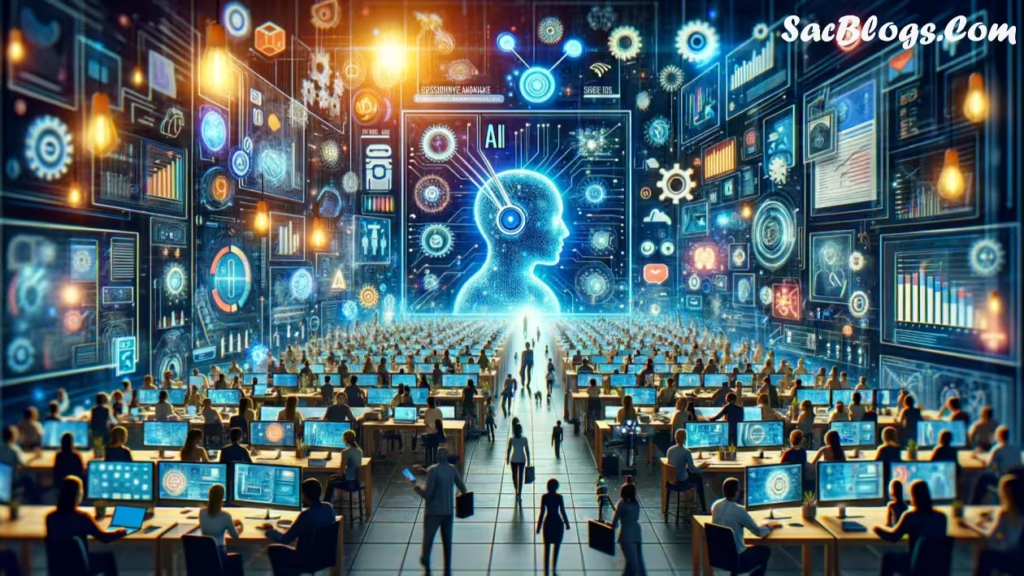From Factories to Freelancing, Pakistan stands at a transformative juncture in its economic development, where artificial intelligence (AI) is rapidly reshaping traditional industries and creating new opportunities in the digital realm. With the recent approval of the National AI Policy 2025, the country has signaled its commitment to embracing technological innovation as a catalyst for economic growth . This comprehensive framework aims to position Pakistan as a knowledge-based economy powered by ethical and inclusive AI adoption, potentially adding Rs24.9 trillion to the economy by 2030 . From automating manufacturing processes to empowering freelancers with cutting-edge tools, AI is fundamentally altering how Pakistan works, produces, and competes in the global marketplace.
The journey from traditional factories to digital freelancing represents more than just an economic shift—it embodies Pakistan’s aspiration to leverage technology for inclusive development. With one of the world’s youngest populations and increasing digital penetration, the country possesses unique advantages that could accelerate its AI transformation. However, significant challenges remain, including infrastructure gaps, skill shortages, and concerns about job displacement. This article examines the multifaceted impact of AI across Pakistan’s economic landscape, exploring both the opportunities and challenges in this digital revolution.
Table of Contents
Pakistan’s National AI Strategy: Building the Foundation
1. Policy Framework and Vision
Pakistan’s National AI Policy 2025 represents a milestone in the country’s technological journey. Framed around six strategic pillars, the policy outlines a future-ready framework designed to guide responsible AI development and deployment . Federal Minister for IT and Telecommunication, Ms. Shaza Fatima Khawaja, describes the policy as “a national commitment to responsible innovation, ethical governance, and inclusive prosperity through AI” . The comprehensive approach aligns with global best practices while addressing Pakistan’s unique developmental needs, aiming to boost socio-economic progress, digital empowerment, and global competitiveness.
The policy’s implementation architecture involves multiple layers of governance, with the Ministry of IT & Telecom (MoITT) serving as the central policy lead . An AI Council chaired by the federal IT minister will oversee implementation, with representation from academia, industry, provincial governments, and civil society . This multi-stakeholder approach reflects the understanding that successful AI adoption requires collaboration across different sectors of society.
2. Key Targets and Initiatives
The National AI Policy sets ambitious but achievable targets that translate vision into measurable outcomes. These include training 1 million AI professionals by 2030, establishing a National AI Fund backed by a permanent 30% allocation of Ignite’s R&D budget, and creating Centers of Excellence in major cities . The policy also aims to deliver 50,000 civic AI projects over five years and support 1,000 homegrown AI solutions .

| Initiative | Target | Timeline |
|---|---|---|
| AI professionals trained | 1,000,000 | By 2030 |
| Annual scholarships | ~3,000 | Ongoing |
| Civic AI projects | 50,000 | 5 years |
| Local AI solutions | 1,000 | 5 years |
| Centers of Excellence | Multiple cities | Short-medium term |
Specific skills development initiatives include training 200,000 individuals annually, awarding 3,000 scholarships, and providing 20,000 paid internships, with special efforts to reach marginalized groups . These programs aim to build a diverse talent pipeline that can support Pakistan’s AI ecosystem across different sectors and regions.
AI Transformation in Traditional Industries
1. Manufacturing and Industrial Sector
Pakistan’s industrial sector, particularly manufacturing, faces significant disruption from AI and automation technologies. A study by the Institute of Policy Studies found that up to 60% of Pakistan’s workforce could be at risk of automation, especially in repetitive and low-value tasks within the textile industry, agriculture, transportation, and office work . This potential displacement poses considerable challenges for a country where labor-intensive sectors form the backbone of the economy.
Despite these challenges, AI presents opportunities for increased productivity and quality in manufacturing. Smart manufacturing technologies enable predictive maintenance, quality control through computer vision, and optimization of supply chains. These innovations can help Pakistani industries reduce costs, improve product quality, and enhance competitiveness in export markets. The policy response must balance the efficiency gains from automation with the social need for employment, potentially through reskilling programs and phased adoption strategies.
2. Agricultural Modernization
Agriculture contributes approximately 24% of Pakistan’s GDP and employs a significant portion of the workforce . AI applications in this sector promise substantial productivity gains—estimated at 20-30%—through precision farming techniques, yield prediction models, and smart irrigation systems . These technologies can help address critical challenges such as water scarcity, crop diseases, and fluctuating yields that affect farmer incomes and food security.
The National AI Policy specifically targets agricultural transformation through sector-specific roadmaps and workforce upskilling . AI-powered advisory platforms can deliver personalized recommendations to farmers based on local conditions, potentially revolutionizing extension services. However, realizing this potential requires addressing infrastructure gaps in rural areas and ensuring that digital solutions are accessible to farmers with varying levels of education and technological proficiency.

The Freelancing Revolution: AI-Enabled Digital Work
1. Growth of the Gig Economy
Pakistan’s freelancing sector has emerged as a significant contributor to the digital economy, with the country consistently ranking among the top freelancing nations globally. AI technologies are accelerating this trend by enabling freelancers to deliver higher-value services with greater efficiency. Tools for AI-generated content, design automation, and data analysis allow Pakistani freelancers to compete in global markets while reducing turnaround times and costs.
The experience of Zubair, a 20-year-old entrepreneur from Karachi, illustrates this transformation. Previously struggling to make ends meet with traditional content creation, he now earns approximately $2,000 per month using AI tools to enhance his productivity . “It used to take me almost five hours to edit thumbnails on Photoshop, but with AI tools, I can do the same work in minutes and get paid the same,” he explains . This efficiency gain allows freelancers to take on more projects or focus on upgrading their skills for higher-value work.
2. Upskilling and Quality Considerations
The democratization of AI tools has created opportunities for freelancers from diverse backgrounds, but it has also raised concerns about quality and authenticity. The proliferation of low-quality AI-generated content—dubbed “slop“—has become noticeable on Pakistani social media platforms . This content often blurs the line between reality and fiction, potentially spreading misinformation or diluting the value of genuine creative work.
Nighat Dad, executive director of the Digital Rights Foundation, notes that while “technology moves fast, adoption outpaces regulation every time” . The ease with which AI tools can generate “fake news, propaganda, or hateful content” poses particular risks in the Pakistani context, where such material “can escalate polarization and even fuel violence” . Addressing these challenges requires a multi-faceted approach including digital literacy, ethical guidelines, and platform accountability.

Economic Impact and Market Potential
1. Projections and Growth Trajectory
Pakistan’s AI market demonstrates significant growth potential, with projections indicating expansion from $861.12 million in 2025 to $3.49 billion by 2031, representing a compound annual growth rate (CAGR) of 26.28% . This growth rate outpaces global averages, reflecting the relatively early stage of adoption and substantial unmet demand across industries. When compared globally, however, Pakistan’s market remains modest—the United States’ AI market is projected to reach $73.98 billion in 2025, highlighting the development gap and growth potential .
The economic impact of AI extends beyond the technology sector itself. Google’s AI solutions added approximately PKR 3.9 trillion ($14 billion) in benefits to Pakistan’s economy in 2023—a 222% increase since 2020 . This broader economic effect reflects how AI technologies enhance productivity and create new value across traditional industries, from agriculture to financial services.
| Metric | Value | Timeframe | Source |
|---|---|---|---|
| AI market size | $861.12m | 2025 | Statista |
| Projected market size | $3.49bn | 2031 | Statista |
| CAGR | 26.28% | 2025-2031 | Statista |
| Economic benefit from Google AI | PKR 3.9tn | 2023 | Access Partnership |
| Potential AI contribution to economy | Rs24.9tn | By 2030 | National AI Policy |
2. Export Potential and Global Competitiveness
AI technologies offer Pakistan opportunities to enhance its global competitiveness and expand exports. The IT sector already reports that up to 30% of their solutions incorporate AI, largely driven by global demand . This trend aligns with the government’s ambition to increase IT exports to $10 billion by FY29 . AI-enabled services and products can help Pakistani companies move up the value chain, delivering more sophisticated solutions that command premium prices in international markets.
The National AI Policy specifically aims to develop Pakistan’s capacity in AI deployment, if not necessarily in fundamental research. Yasar Ayaz, chairman of Pakistan’s National Center of Artificial Intelligence, notes: “We don’t have the capacity to become AI developers, but we are making strides in deployment. We have several products and solutions that can be exported to other low-income countries, as our needs are similar” . This pragmatic approach focuses on applying AI solutions to development challenges that resonate across similar economies.
Challenges and Implementation Hurdles
1. Infrastructure and Readiness Gaps
Despite ambitious policy goals, Pakistan faces significant infrastructure challenges that could hinder AI adoption. The country trails in global AI readiness rankings, placed eighth out of 17 countries in South and Central Asia—behind India, Bangladesh, and Sri Lanka . Critical infrastructure gaps include limited AI-ready data centers, unreliable power supply, and variable internet connectivity, particularly in rural areas.
Restrictions on storing sensitive data abroad further complicate AI adoption for many organizations . Without adequate local data infrastructure, businesses face difficult choices between compliance and capability. The government’s plan to reserve 2,000 MW of surplus electricity for bitcoin mining and AI data centers represents a step toward addressing this constraint , but more comprehensive infrastructure investments will be necessary.
2. Skills Development and Digital Divide
The transition to an AI-enabled economy requires substantial investment in human capital. While Pakistan boasts a large youth population with generally high AI awareness—76% of Pakistanis are familiar with ChatGPT, ranking fourth globally —there remains a significant gap between awareness and professional skills. Natasha Uderani, co-founder of Data Darbar, emphasizes the need for “more vocational programs to upskill the current workforce” .
The digital divide presents additional challenges to inclusive AI adoption. Women, rural communities, and less-educated populations risk being left behind without targeted interventions. The National AI Policy includes provisions for inclusion, but translating these commitments into practical programs will require substantial resources and careful implementation. Mehwish Salman Ali, Member AI committee at P@SHA, emphasizes the need to prepare 1 million IT graduates in the next two years, which requires “joint efforts and a uniform structure” .
3. Ethical and Regulatory Considerations
The rapid adoption of AI technologies outpaces regulatory frameworks, creating ethical risks and potential for harm. The Digital Rights Foundation has uncovered networks of YouTube channels that use AI to generate misleading content presented as official government information . Such deceptive practices undermine trust in digital platforms and public institutions alike.
Pakistan’s AI policy addresses these concerns through provisions for regulatory sandboxes, cybersecurity protocols, and transparency frameworks . However, implementing these safeguards effectively while maintaining an innovation-friendly environment represents a delicate balancing act. As Abrar ul-Hassan of Morango Films notes, “AI upskilling is not just about the tech, but the ethical understanding, as well” .

Future Prospects: Navigating the AI Transformation
1. Strategic Priorities for Implementation
Successful implementation of Pakistan’s AI ambitions will require focused attention on several strategic priorities. First, establishing the proposed Centers of Excellence in major cities can create critical mass for research and application development . These centers should prioritize use cases with high social and economic impact, particularly in health, agriculture, education, and governance.
Second, developing data infrastructure is essential for enabling AI innovation. This includes not only physical data centers but also data governance frameworks that balance accessibility with privacy and security. The policy’s proposed national compute grid and centralized datasets could significantly reduce barriers to entry for startups and researchers if implemented effectively.
Third, international collaboration can help accelerate Pakistan’s AI development through knowledge transfer and access to global best practices. The policy envisions “bilateral and multilateral agreements with AI-leading nations” and participation in global AI forums . Such partnerships can help address capacity constraints while positioning Pakistani solutions for global relevance.
2. Balancing Automation and Employment
Perhaps the most delicate challenge involves balancing productivity gains from automation with the need to preserve and create employment opportunities. With up to 60% of the workforce potentially vulnerable to automation , policymakers must design transition pathways that minimize disruption while maximizing the benefits of AI technologies.
This balancing act requires complementary investments in education and social protection systems. Vocational training programs should emphasize skills that complement rather than compete with AI capabilities, such as creativity, emotional intelligence, and complex problem-solving. Social safety nets may need strengthening to support workers during transitions between industries or occupations.

Conclusion: Toward an Inclusive AI-Powered Future
Pakistan’s journey from factories to freelancing through AI adoption represents both tremendous opportunity and significant challenge. The National AI Policy 2025 provides a comprehensive framework for harnessing these technologies toward national development goals, but its success will depend on effective implementation and continuous adaptation to technological changes.
The transformative potential of AI extends across traditional industries and emerging digital sectors alike. From precision agriculture that enhances food security to AI-enabled freelancing that generates export earnings, these technologies can contribute to broader economic development if deployed thoughtfully and inclusively. However, realizing this potential requires addressing infrastructure gaps, building human capital, and establishing governance frameworks that encourage innovation while mitigating risks.
As Pakistan navigates this complex transformation, the ultimate goal should be an AI ecosystem that enhances human capabilities rather than replacing them, that creates opportunities for all segments of society, and that directs technological progress toward solving pressing development challenges. With careful planning and execution, AI can indeed help transform Pakistan into a knowledge-based economy that benefits from both modern factories and digital freelancing.
Read Also : AI and Automation in Pakistan – How Technology is Reshaping the Future of Work
Frequently Asked Questions (FAQs)
u003cstrongu003eWhat is Pakistan’s National AI Policy 2025?u003c/strongu003e
Pakistan’s National AI Policy 2025 is a comprehensive framework approved by the Federal Cabinet to guide the development and deployment of artificial intelligence in the country. It revolves around six strategic pillars: building an AI innovation ecosystem, awareness and readiness, creating a secure AI environment, sectoral transformation, infrastructure development, and international collaboration .
u003cstrongu003eHow will AI impact jobs in Pakistan’s industrial sector?u003c/strongu003e
AI is expected to significantly impact Pakistan’s industrial sector, with up to 60% of the workforce potentially at risk of automation, particularly in repetitive tasks in textiles, agriculture, and transportation . While this may lead to job displacement in some areas, AI also creates opportunities for higher-value work and requires reskilling programs to help workers transition.
u003cstrongu003eWhat are the economic projections for AI in Pakistan?u003c/strongu003e
Pakistan’s AI market is projected to reach $861.12 million in 2025, growing at a CAGR of 26.28% to reach $3.49 billion by 2031 . The overall contribution to the economy is estimated to be approximately Rs24.9 trillion by 2030 .
u003cstrongu003eHow is AI transforming freelancing in Pakistan?u003c/strongu003e
AI tools are enabling Pakistani freelancers to work more efficiently and offer higher-value services. For example, some freelancers have reported being able to complete graphic design tasks in minutes instead of hours, significantly increasing their earning potential . However, there are also concerns about the proliferation of low-quality AI-generated content.
u003cstrongu003eWhat are the main challenges to AI adoption in Pakistan?u003c/strongu003e
Key challenges include infrastructure gaps (particularly limited AI-ready data centers), skills shortages, regulatory uncertainties, and concerns about job displacement. Pakistan also trails regional peers in AI readiness rankings .
u003cstrongu003eHow does Pakistan plan to develop AI talent?u003c/strongu003e
The National AI Policy aims to train 1 million AI professionals by 2030 through various initiatives, including training 200,000 individuals annually, offering 3,000 scholarships, and providing 20,000 paid internships . Centers of Excellence in major cities will support these efforts.
u003cstrongu003eWhat measures are included to ensure ethical AI use in Pakistan?u003c/strongu003e
The policy includes provisions for regulatory sandboxes, cybersecurity protocols, transparency frameworks, and mandatory human oversight for sensitive AI systems . These measures aim to protect data and ensure ethical AI use.
u003cstrongu003eHow is AI being applied in Pakistan’s agricultural sector?u003c/strongu003e
AI applications in agriculture include precision farming techniques, yield prediction models, and smart irrigation systems. These technologies have the potential to increase productivity by 20-30% , addressing challenges like water scarcity and crop diseases.
u003cstrongu003eWhat role can international collaboration play in Pakistan’s AI development?u003c/strongu003e
International collaboration through bilateral agreements, participation in global AI forums, and alignment with international standards is envisioned as a key pillar of Pakistan’s AI strategy . Such partnerships can facilitate knowledge transfer and access to best practices.
u003cstrongu003eHow does Pakistan’s AI readiness compare to regional countries?u003c/strongu003e
According to a report by Oxford Insights, Pakistan ranks eighth out of 17 countries in South and Central Asia in AI readiness, behind India, Bangladesh, and Sri Lanka . This indicates significant room for improvement in the country’s AI capabilities and infrastructure.







1 thought on “From Factories to Freelancing – How AI is Reshaping Pakistan’s Economic Landscape”